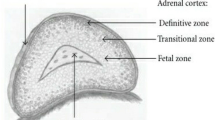Abstract
Introduction
There is a definite need to find a highly sensitive and specific, noninvasive, and cost-effective marker for prediction of preterm labor. We hypothesize that a measurement of adrenal gland volume can predict a preterm as well as a term labor.
Materials and Methods
Two hundred and sixty-eight pregnant women were enrolled in the study at 28–34 weeks’ antenatal visit. Final analysis was done in 204. All of them were subjected to 2D ultrasonographic measurement of the corrected fetal adrenal gland volume (cFAGV) and fetal adrenal zone parameters including the width ratio and depth ratio. The cohort was followed up to term, and a reassessment of cFAGV and fetal adrenal zone parameters was repeated between 37 and 39 weeks. Women who presented with features of preterm labor had a scan at the time of presentation to record cFAGV and fetal adrenal zone parameters.
Results
Women, who developed features of preterm labor eventually, had a significantly high cFAGV (404.70 mm3/kg body weight) during the first scan compared to those who reached term asymptomatically (241.35 mm3/kg body weight). A cutoff value of 271.16 mm3/kg body weight showed 90% sensitivity and 81.9% specificity. Fetal adrenal gland width ratio had the best efficacy (sensitivity 96.67%, specificity 86.2%) followed by cFAGV (sensitivity 96.67%, specificity 83%) for predicting preterm delivery.
Conclusion
2D ultrasound measurement of fetal adrenal gland parameters can be used as a marker for prediction of preterm delivery. cFAGV at term can also be used to predict the possibility of spontaneous onset of labor.


Similar content being viewed by others
References
Zhang J, Sundaram R, Sun W, et al. Fetal growth and timing of parturition in humans. Am J Epidemiol. 2008;168(8):946–51.
Alcantara-Alonso V, Panetta P, de Gortari P, et al. Corticotropin—releasing hormone as the homeostatic rheostat of feto-maternal symbiosis and developmental programming in utero and neonatal life. Front Endocrinol. 2017;8:161.
Turan OM, Turan S, Buhimschi IA, et al. Comparative analysis of 2-D versus 3-D ultrasound estimation of the fetal adrenal gland volume and prediction of preterm birth. Am J Perinatol. 2012;29(9):673–80.
Turan OM, Turan S, Funai EF, et al. Ultrasound measurement of fetal adrenal gland enlargement: an accurate predictor of preterm birth. Am J Obstet Gynecol. 2011;204(4):311e1-10.
Goldenberg RL, Culhane JF, Iams JD, et al. Epidemiology and causes of preterm birth. Lancet. 2008;371:75–84.
Matthew K. Hoffman, ultrasound measurement of the fetal adrenal gland as a predictor of spontaneous preterm birth. Obstet Gynecol. 2016;127(4):726–34.
Van Vuuren SH, Damen-Elias HA, Stigter RH, et al. Size and volume charts of fetal kidney, renal pelvis and adrenal gland. Ultrasound Obstet Gynecol. 2012;40(6):659.
Guler AE, Pehlivan H, Cakmak B, et al. Assessment of fetal adrenal gland enlargement in term and preterm labor cases. Int J Res Med Sci. 2015;3(5):1035–40.
Kashyap V, Kashyap N, Khanna S, et al. Role of adrenal fetal zone and its vascularity to predict successful labour induction outcomes and also to predict preterm labour. Ultrasound Obstet Gynecol. 2016;48(suppl 1):167–269.
Author information
Authors and Affiliations
Corresponding author
Ethics declarations
Conflict of interest
The authors declare that they have no conflict of interest.
Human and Animal Rights
This research involved no human participants and/or animals.
Informed Consent
Informed consent was obtained from all the patients in the study.
Additional information
Chandana S. Bhat is a Junior Resident in the Department of OBG, KMC Manipal, Manipal University, Manipal, Karnataka. Sapna Vinit Amin is a Associate Professor in the Department of OBG, KMC Manipal, Manipal University, Manipal, Karnataka. Prashanth Adiga is a Professor in the Department of OBG, KMC Manipal, Manipal University, Manipal, Karnataka. Deeksha Pandey is a Associate Professor in the Department of OBG, KMC Manipal, Manipal University, Manipal, Karnataka.
Rights and permissions
About this article
Cite this article
Bhat, C.S., Amin, S.V., Adiga, P. et al. Fetal Adrenal Gland Volume a Novel Predictor of Onset of Labor. J Obstet Gynecol India 69, 252–257 (2019). https://doi.org/10.1007/s13224-018-1187-4
Received:
Accepted:
Published:
Issue Date:
DOI: https://doi.org/10.1007/s13224-018-1187-4




